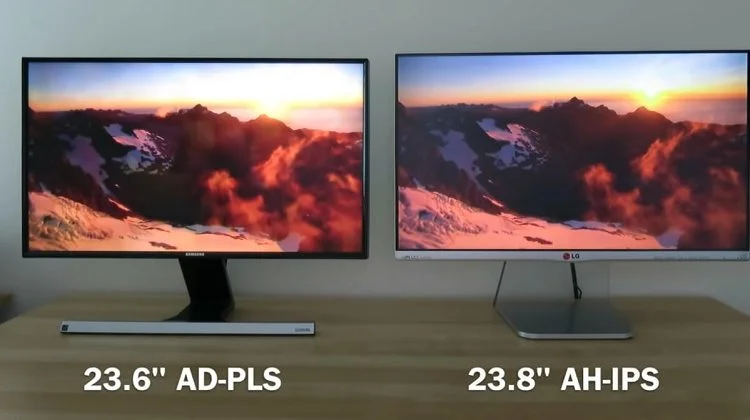What Is a PLS Screen?
PLS (Plane-to-Line Switching) is Samsung’s take on wide-angle TFT LCD technology, offering a powerful alternative to traditional IPS panels.
At its core, a PLS display uses the same horizontal alignment of liquid crystals as IPS—but with patented twists designed to:
- Deliver striking color uniformity, even from off-axis views
- Improve light transmittance, yielding brighter visuals at the same power
- Enhance overall image quality with Samsung’s proprietary refinements
PLS appears most often in Samsung-branded monitors, tablets, and professional-grade devices where consistent color across the screen is essential—even though it’s less widespread than IPS in the broader market.
What Is an IPS Panel?
IPS (In-Plane Switching) is the industry-standard wide-angle LCD technology found across brands like LG, Dell, and Apple. It was originally developed by Hitachi and gained traction for its:
- Ultra-wide viewing angles (up to 178°) with minimal color shift
- High color accuracy and depth suitable for color-critical applications
- Exceptional consistency across entire screen surfaces
This reliability has made IPS the default choice for high-end monitors, medical displays, creative tools, and precision industrial UIs.
PLS vs. IPS: How Do They Compare?
Here’s a side-by-side look at how PLS stacks up against IPS across key metrics:
| Feature | PLS Screen | IPS Panel |
|---|---|---|
| Viewing Angle | Excellent (≈178°) | Excellent (≈178°) |
| Color Uniformity | Very high | Industry benchmark |
| Brightness Efficiency | Slightly higher | Depends on panel grade |
| Contrast & Black Level | Moderate (≈1000:1) | Slightly superior on premium IPS |
| Response Time | ~5–8 ms | ~5–8 ms |
| Cost Efficiency | Often more affordable | Varies with brand and quality |
| Ecosystem & Supply | Samsung-centric | Broad support (LG, AUO, BOE etc.) |
In practice, engineers often see PLS as Samsung’s optimized version of IPS. It delivers comparable or slightly better performance in some areas—especially perceived brightness and price—while staying true to IPS’s visual strengths.
Are PLS Screens Better Than IPS?
Not exactly—but not worse either.
For most users and industrial applications, the differences between PLS and IPS are subtle. However, here are a few practical distinctions worth noting:
- Power or brightness optimization: PLS panels may require less backlight for a given luminance, so they can deliver the same brightness with lower energy.
- Color-critical applications: Premium IPS panels, including variants like AH-IPS or Nano IPS, may still hold an edge for ultra-precise color workflows.
- Supply chain considerations: PLS is Samsung-specific, while IPS offers a broader vendor base—important for long-term procurement.
Where IPS Still Leads
IPS remains the go-to in settings where visual fidelity matters most:
- Professional photo/video editing and color grading
- Medical diagnostic displays
- High-end consumer tablets (e.g., iPads, Surface devices)
- Automotive infotainment systems demanding wide viewing angles
- Industrial user interfaces where consistent quality is key
Due to its broad manufacturer support and myriad panel grades, IPS offers flexibility in feature-rich or regulated applications.
Choosing Between PLS and IPS for Your Display Project
Here’s a practical matrix to help you decide:
| Application | Recommended Panel |
|---|---|
| General office or industrial GUI | PLS or IPS |
| Budget-sensitive hardware deployments | PLS |
| Color-accurate content creation | IPS (premium grade) |
| High brightness or outdoor display needs | PLS or high-end IPS |
| Broad display vendor access and compatibility | IPS |
Your final choice should also factor in panel dimensions, interface compatibility (RGB, MIPI, LVDS), brightness goals, budget, and long-term availability.
Frequently Asked Questions
Q1: Are PLS screens just rebranded IPS?
Not exactly. PLS uses similar liquid crystal physics but includes engineering optimizations by Samsung—for example, better light transmission and focus on uniformity.
Q2: Do PLS panels use less power?
Sometimes. Because of improved optical efficiency, they can reach desired brightness using less backlight with the same power budget.
Q3: Can I expect the same color output from IPS and PLS?
For most mid-range panels, yes—differences are subtle. In high-end, color-professional IPS panels, small improvements in consistency may be noticeable.
Q4: Can I replace an IPS display with a PLS panel on my product?
Yes—provided the panel sizes, timing specs, and electrical interfaces match. You may need to adjust display tuning or color mapping.
Q5: Which performs better outdoors?
PLS may offer better brightness efficiency per watt, but both benefit significantly from optional optical bonding or anti-glare coatings.
Final Thoughts
Both PLS and IPS deliver excellent viewing experiences, wide color gamuts, and strong viewing angles. If you’re sourcing display modules for embedded systems—especially Samsung-compatible ones—PLS may reduce cost and boost brightness. If you require wide vendor options and advanced color grading precision, IPS remains unbeatable in flexibility.
In short: neither is inherently better, but each has its sweet spot depending on your application needs.
